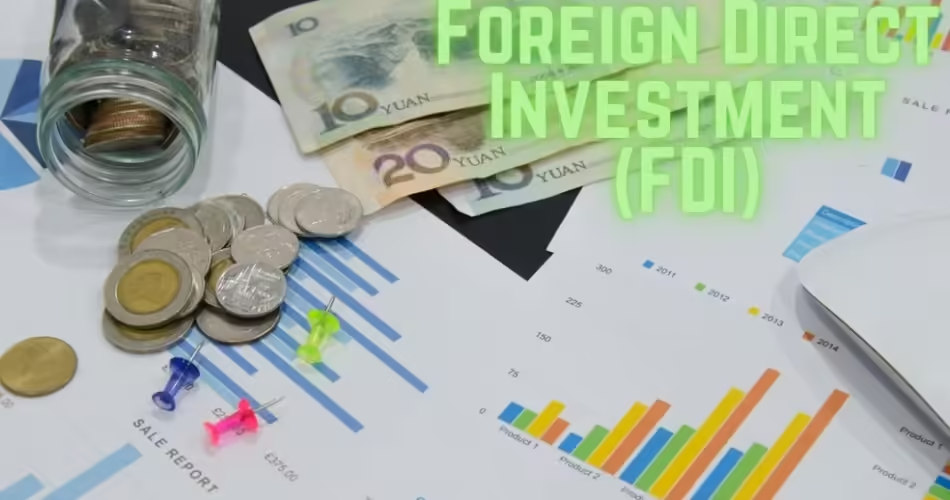This blog contains information about Foreign Direct Investment in detail. It starts with the Definition and Introduction of Foreign Direct Investment or FDI. Then it mentions Example of FDI. It also explains the term International Economic Integration of IEI. In the end, it elaborates the Types of Foreign Direct Investment. This blog contains definition and Types of Foreign Direct Investment.
Definition of Foreign Direct Investment:
Foreign Direct Investment or FDI is the investment in which an investor or a company from a country invests in the other country to multiply the business.
This highly depends on the level of trust and resources. Nobody should invest without promising loyalty between both of the dealers. The one who is investing is more likely to face loss in the case of mismanagement and disloyalty.
Foreign direct investment comprises of a great role in the economy of countries, especially developing nations that are not capable of managing big projects and investments on their own. So, FDI is key element in international economic integration.
It is basically an interest in a company by an investor located in another company. This play a big role in economic concepts in the world.
Example of Foreign Direct Investment:
In Pakistan, Power sector receives USD 139.7 million FDI
Oil and Gas sector receives USD 87.8 million FDI
While, Financial Business Sector receives USD 85.9 million FDI etc.
International Economic Integration:
It is defined as an agreement between nations to reduce or eliminate trade barriers and agree on fiscal policies. This integration helps in improvement of trade between the nations and eventually increase GDP and export income of the countries. It can be considered as the healthy activity to go forward on the road of success for the nations. Some nationalists may oppose this integration. They may consider it as sovereignty.

Types of FDI:
Following are the basic types of Foreign Direst Investment:
1.Horizontal FDI:
It is the investment made by a domestic company into a foreign entity belonging to the same industry. It means that if a company manufactures fast fashion products, then it will invest in any company in another nation manufacturing the same type of products. Horizontal FDI also includes if a company starts its franchise or branch in any other country. It plays a very important role in creating international revenue for a company and increase market share.
2.Vertical FDI:
This type of investment occurs when a country invests in a company that invests in a different chain processes in foreign locations. Vertical FDI can occur in two ways:
Backward integration: The first way is that any international company can invest in any other company at lower stages i.e. raw material, manufacturing etc. In reverse joining manages this cycle: Organizations assess potential chances to get or converge with a provider used to create their items or administrations. They complete reasonable level of investment and a M&A exchange when the advantages of in reverse combination are legitimate and monetarily plausible. In reverse mix is a type of vertical coordination.
Forward Integration: The second type is that company can invest in higher stages such as foreign branches of any company in other countries. Frequently alluded to as “removing the broker,” forward incorporation is a functional methodology executed by an organization that needs to increment command over its providers, producers, or merchants, so it can build its market power.
These are the sub-types of Vertical FDI and this investment can be in any sector.
3.Conglomerate FDI:
When an investor provides investment to any company that does not relates to the existing businesses of the investor, it is called as Conglomerate FDI. Such as a foreign Pharmaceutical company invests in any automobile manufacturing company. It can be challenging for the investor to invest in the entirely different sector because he will have no experience about that sector and there is a possibility to bear the loss in the deal.
4.Platform FDI:
Many multinational companies uses a country as their platform or hub for global operations and identity for that company, this is known as Platform FDI. Platform FDI is the most complex one because it use inter-relation of countries in their working. Any multinational company may use any country on the list as a platform and operate all the business operations from that country.
Advantages of Foreign Direct Investment:
Following are some Advantages of FDI:
It provides much needed capital to a country.
FDI may lead to the transfer of technology and information about it from country to country.
It creates a lot of job opportunities in needy nations and helps to improve the economy.
This helps to earn foreign exchange earnings in a large amount.
It can help in fighting with unemployment in a country.
By FDI a country transfers its assets and also capital to other needy nations to stabilize money flow.
It creates proper relations with countries by exchanging FDI.
These are few advantages of FDI.
Disadvantages of Foreign Direct Investment:
Following are the Disadvantages of FDI:
The country that hosts FDI may lose control over its economy.
People may lose jobs in the hosting country.
There can be few negative impacts of the Foreign Investment in the extractive industries.
FDI may create a lot of social tensions as foreign companies’ goals conflict with local people.
Major resources may be available for the needy country and there will be deficiency of resources in hosting country.
These are few disadvantages of FDI.

Conclusion:
Foreign Direct Investment is called as an investment made by a country into any company based in another country. In this investment, trust and loyalty is highly considered because the investor may not claim easily when he bears loss. There are four types of FDI according to their way of investing in international market. FDI play a great role in improving the economy of the countries and developing authentic and strong international relations between nations. This blog contains Types of Foreign Direct Investment in detail.
To learn about more topics, Click the links below:
Role of Government and NGOs in Disaster Management


Comments